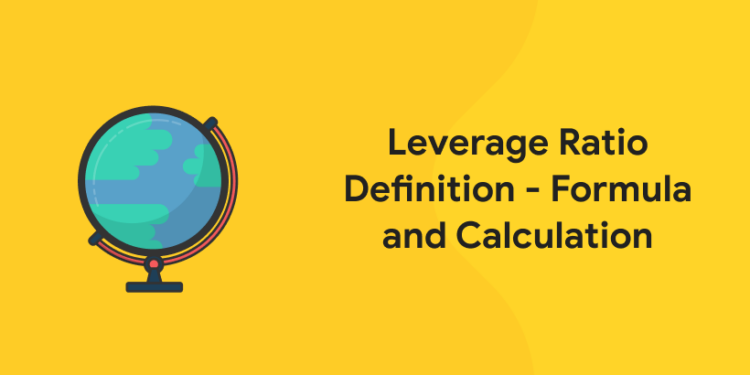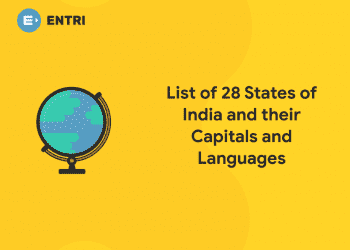Table of Contents
A leverage ratio is one of several financial measurements that look at how much capital comes in the form of loans (debt) or assesses the ability of an organisation to meet its financial obligations. The leverage ratio category is significant because organisations rely on a combination of equity and debt to finance their dealings, and knowing the amount of debt held by an organisation is useful in evaluating whether it can pay off its debts as they come due. Several common leverage ratios are discussed in this article.
Meaning of Leverage Ratio
Too much debt can be dangerous for an organisation and its investors. However, if a company’s dealings can provide a higher rate of return than the interest rate on its debts, then the loan may help to fuel growth. Uncontrolled debt levels can cause credit downgrades or worse. On the other hand, very little debts can also raise questions. A hesitancy or inability to borrow may be a sign that operating boundaries are tight.
There are several types of ratios that may be categorized as a leverage ratio, but the main factors taken into consideration are debt, assets, equity and interest expenses.
A leverage ratio may also be used to measure an organisation’s combination of operating expenses to get an idea of how changes in output will affect operating income. Fixed and variable costs are the 2 types of operating costs; depending on the organisation and the industry, the mix will vary.
Lastly, the user leverage ratio refers to the level of user debt compared to disposable income and is used in economic analysis and by policy-makers.
Banks and Leverage Ratios
Banks are among the most leveraged organisations in the United States of America. The combination of fractional-reserve banking and FDIC or Federal Deposit Insurance Corporation protection has produced a banking environment with minimal lending risks.
To compensate for this, 3 distinct regulatory bodies, the FDIC, the Federal Reserve, and the Comptroller of the Currency, review and control the leverage ratios for American banks.
This means they control how much money a bank can lend relative to how much capital the bank provides to its own assets. The level of capital is crucial because banks can write down the capital portion of their possessions if total asset values drop. Assets financed by debt cannot be written down because the bank’s bondholders and depositors owe those funds.
Attempt free GK Mock Test! Download Entri App!
Banking regulations for leverage ratios are complex. The Federal Reserve gave guidelines for bank holding companies, although these limitations change depending on the rating assigned to the bank. In general, banks that experience speedy growth or face functional or financial difficulties are required to maintain higher leverage ratios.
There are several types of capital requirements and minimum reserve placed on American banks through the FDIC and the Comptroller of the Currency that indirectly affects leverage ratios. The level of investigation paid to leverage ratios has increased since the Major Recession of 2007 to 2009 when banks that were “too big to fail” were the main reason to make banks more solvent. These limitations naturally limit the number of loans made because it is more difficult and more costly for a bank to raise capital than it is to borrow funds. Higher capital needs can reduce dividends or dilute share value if more shares are given.
For banks, the tier 1 leverage ratio is most normally used by officials.
Leverage Ratios for Evaluating Financial Condition and Capital Structure
The most widely used financial leverage ratio is the debt to equity ratio.
The Debt to Equity or D/E Ratio
This is expressed as:
{Debt-to-Equity Ratio} = {Total Liabilities}/{Total Shareholders’ Equity}
For example, United Parcel Service’s long-term debt for the quarter ending December 2019 was dollar 21.8 billion. Its total stockholders’ equity for the ending December 2019 was dollar 3.3 billion. The company’s Dept to Equity or D/E for the quarter was 8.62. It is considered to be very high.
A high debt or equity ratio generally shows that a company has been aggressive in financing its growth with debt. This can cause volatile earnings as a result of the additional interest expense. If the firm’s interest expense grows too high, it may increase the firm’s chances of a default bankruptcy.
Typically, a D/E ratio greater than 2.0 signals a risky scenario for an investor; however, this yardstick can vary with organisation. Businesses that needs large capital expenditures (CapEx), such as utility and manufacturing firms, may need to take more loans than other organisations. It’s a good thought to measure a firm’s leverage ratios against previous performance and with companies working in the same industry to better understand the data. Fedex has a Dept to Equity ratio of 1.78, so there is reason for concern where UPS is concerned. However, most analysts believe that UPS earns enough cash to screen its debts.
The Equity Multiplier
The equity multiplier is similar to D/E Ratio, but replaces debt with assets in the numerator:
{Equity Multiplier} = {Total Assets}/{Total Equity}
For example, assume that Macy’s (NYSE: M) has assets valued at dollar 19.85 billion and stockholder equity of dollar 4.32 billion. The equity multiplier would be:
{19.85 billion}/{4.32 billion} = 4.59
Although debt is not specifically included in the formula, it is an understood that the total assets includes debt.
We know that Total Assets is given by the sum of Total Debt and Total shareholders’ Equity. The firm’s high ratio of 4.59 means that assets are mostly funded with loan than equity. From the equity multiplier formula, Macy’s assets are financed with dollar 15.53 billion in liabilities.
The equity multiplier is a component of the DuPont analysis for calculating ROE or return on equity:
DuPont analysis=NPM × AT× EM
where: NPM =net profit margin, AT = asset turnover and EM = equity multiplier
Attempt free GK Mock Test! Download Entri App!
The Debt to Capitalization Ratio
An indicator that gives the amount of debt in an organisation’s capital structure is the debt to capitalization ratio, it gives a company’s financial leverage. It is calculated as:
Total debt to capitalization = (SD + LD + SE)(SD +LD)
where: SD = short-term debt, LD = long-term debt and SE = shareholders’ equity
In this ratio, operating belongings are capitalized and equity consists of both common and preferred shares. Instead of using long-term debt, an analyst may settle to use total debt to measure the debt used in a company’s capital structure. The formula, in this case, would also have the minority interest and preferred shares in the denominator.
Degree of Financial Leverage
DFL or Degree of financial leverage is a ratio that provides the sensitivity of a firm’s EPS or earnings per share to fluctuations in its operating income, as an effect of changes in its capital structure. It measures the percentage change in earnings per share for a unit change in EBIT or earnings before interest and taxes and is given by the following formula:
DFL=% change in EBIT and % change in EPS
where: EPS = earnings per share, EBIT = earnings before interest and taxes
DFL can also be represented by the equation below:
DFL = EBIT −interest EBIT
This ratio tells that the higher the degree of financial leverage, the more volatile the earnings will be. Since interest is usually a fixed expense, leverage enlarges returns and EPS. This is good when operating income is increasing, but it can be a problem when operating income is not that good.
Grab study materials to strengthen your GK !!! Register Now !!!
The Consumer Leverage Ratio
The consumer leverage ratio is used to quantify the amount of loan the average American user has relative to their disposable income.
Some economists have said that the rapid increase in consumer loan levels has been a contributing factor to corporate earnings growth over the past few years. Others blamed the high level of consumer loan as a major reason for the great recession.
Consumer leverage ratio = Disposable personal income / Total household debt
Understanding how debt increases returns is the key to understanding leverage. Loan is not necessarily a bad thing, particularly if it is taken on to invest in projects that will generate positive returns. Leverage can thus multiply returns, even though it can also increase losses if returns turn out to be negative.
The Debt to Capital Ratio
The debt-to-capital ratio is a measurement of a firm’s financial leverage. It is one of the more meaningful debt ratios as it focuses on the relationship of debt liabilities as a component of a organisation’s total capital base. Debt consists of all short term and long term obligations. Capital includes the firm’s debt and shareholders’ equity.
This ratio is used to understand a firm’s financial structure and how it is financing operations. Typically, if a firm has a high debt to capital ratio compared to its competitors, it may have a higher default risk due to the effect the loan has on its operations. The oil firm seems to have about a 40% debt to capital threshold. Above that level, debt costs increase significantly.
The Debt to EBITDA Leverage Ratio
The debt to EBITDA leverage ratio measures a firm’s ability to pay off its incurred debt. Commonly used by credit agencies, this ratio gives the probability of defaulting on issued loan. Since oil and gas firms typically have a lot of debt on their balance sheets, this ratio is useful in finding how many years of EBITDA would be needed to pay back all the debt. Typically, it can be shocking if the ratio is over 3, but this can vary depending on the firm.
The Debt to EBITDAX Ratio
Another form of the debt to EBITDA ratio is the debt-to EBITDAX ratio, which is similar, except EBITDAX is EBITDA before exploration costs for successful efforts firms. This ratio is commonly used in the US to normalize different accounting treatments for exploration expenses (the full cost method vs the successful efforts method).
Exploration costs are typically found in the financial statements as abandonment, exploration and dry hole costs. Other non cash expenses that must be added back in are accretion of asset retirement obligations, impairments, and deferred taxes.
The Interest Coverage Ratio
Another leverage ratio considered along with interest payments is the interest coverage ratio. One problem with only reviewing the total debt liabilities for a firm is they do not tell you anything about the firm’s ability to service the debt. This is exactly what the interest coverage ratio intent to fix.
This ratio, which equals operating income divided by interest expenses, displays the firm’s ability to make interest payments. Generally, a ratio of 3.0 or higher is preferred, although this changes from industry to industry.
Attempt free GK Mock Test! Download Entri App!
The Fixed-Charge Coverage Ratio
TIE or Times interest earned , also called the fixed-charge coverage ratio, is another form of the interest coverage ratio. This leverage ratio tries to highlight flow of cash proportionate to interest owed on long-term liabilities.
To calculate this ratio, find the firm’s EBIT or earnings before interest and taxes, then divide by the interest expense of long-term debts. Use pre-tax earnings as interest is tax-deductible; the full sum of earnings can eventually be used to pay interest. Again, higher numbers are more preferred.
When Does Leverage Ratio Become Useful?
Leverage ratios—like most financial terms used by investors to evaluate firms they are most useful when comparing two or more firms within the same industry. Different industries have different norms in terms of loan and financing, so comparing the leverage ratio of a bank to that of an manufacturer would not give much insight.
Comparing the leverage ratios of two firms within the same industry, on the other hand, could provide valuable information about which might be a safer investment. It’s important to note, that the safer investments are not always better investments. Riskier investments can give more considerable returns, but they can also result in bigger losses.
Leverage Ratio Example:
In this section we use leverage ratios to compare Microsoft and Apple, the 2 large and popular computer firms.
Microsoft vs. Apple
Comparing the leverage ratios of Microsoft or Nasdaq: MSFT and Apple or Nasdaq: AAPL can not tell us which firm is a better investment, nor can it tell us which firm’s stock price has a better value. It can, however, tell us how reliant on debt each firm at present is to sustain its operations. In times of economic uncertainty like recessions organisations that are less reliant on debt may be safer investments.
Note: The figures below are taken from the 2021 financial statements provided by Microsoft and Apple.
Microsoft Apple
Short-term debt: Dollar 1.96 billion
Short-term debt: Dollar 7.45 billion
Long-term debt: Dollar 71.45 billion
Long-term debt: Dollar 119.38 billion
Shareholders’ equity: Dollar 141.99 billion
Shareholders’ equity: Dollar 63.09 billion
Total assets: 333.78 billion
Total assets: Dollar 351 billion
Microsoft’s Leverage Ratios
Debt to Equity
D/E = (Short-Term Debt + Long-Term Debt) / Shareholders’ Equity
D/E = (1.96 + 71.45) / 141.99
D/E = 73.41 / 141.99
D/E = 0.517
Debt to Total Assets
D/TA = (Short-Term Debt + Long-Term Debt) / Total Assets
D/TA = (1.96 + 71.45) / 333.78
D/TA = 73.41 / 333.78
D/TA = 0.219
Attempt free GK Mock Test! Download Entri App!
Apple’s Leverage Ratios
Debt to Equity
D/E = (Short-Term Debt + Long-Term Debt) / Shareholders’ Equity
D/E = (7.45 + 119.38) / 63.09
D/E = 126.83 / 63.09
D/E = 2.01
Debt to Total Assets
D/TA = (Short-Term Debt + Long-Term Debt) / Total Assets
D/TA = (7.45 + 119.38) / 351
D/TA = 126.83 / 351
D/TA = 0.361
From these leverage ratios, it is evident that in 2021, Apple was more debt-reliant than Microsoft. Apple’s debt accounted for about two times as much of its operations as its equity, whereas Microsoft’s debt accounted for only about half as much of its operations as its equity. About 22% of Microsoft’s total assets were financed by loan, whereas about 36% of Apple’s total assets were financed by loan.
Overall, these calculations tell us that Apple is more highly leveraged than Microsoft and as a result may be a riskier investment (within the computer industry) during bear markets or recessions.
What do you mean by High Leverage Ratio?
As mentioned above, one firm’s leverage ratios being higher than another’s does not mean much if the 2 firms are in different industries, especially if one has been here for a lot longer period than the other.
Within an industry, however, if 2 firms are of similar size and age, and one has considerably higher leverage ratios, that could indicate that it is a riskier investment, especially during low revenue period. In the event that both firms have revenue troubles, the one with the higher leverage ratios is more likely to become bankrupt.
What do you mean by Low Leverage Ratio ?
If two firms are comparable (in terms of industry, size, and age), but one has considerably lower leverage ratios than the other, the less-leveraged firm could be considered a safer investment. If both firms struggle to achieve revenue, the less-leveraged company is less likely to become bankrupt.
What do you mean by Good Leverage Ratio?
What is considered a “good” or below average leverage ratio varies significantly with industry, as certain types of firms are by nature more reliant on debt than others to fund operations. For instance, the average D/E ratio in the auto firm as of January 2022 was about 0.2, while the average for banks was 1.7.
Grab study materials to strengthen your GK !!! Register Now !!!
Leverage Ratio: Quiz
1. You’ve paid INR 25,000 of your INR 200,000 house. What is your leverage ratio?
a)5
b) 4
c) 7
d) 8
Ans (c) 7
2. Your home suddenly increases in value. What happens to your owner’s equity?
a) It decreases.
b) It increases.
c) The value of the house is irrelevant to owner’s equity.
d) It relies on the change in price level since the home purchase.
Ans (b) It increases
3. You own a home for which you paid INR 10,000 in down payment and have since paid off another INR 20,000. Your leverage ratio is 4. If the value of the home falls below ___________, you will be underwater.
a) INR 150,000
b) INR 130,000
c) INR 120,000
d) INR 90,000
Ans (c) INR 120,000
4. If you believe in the basic principle of a risk-reward relationship, your conclusion regarding security ratings and yields between an Aaa bond and a Baa bond would be that:
a) there would be lower yield on the Aaa bond.
b) there would be higher yield o the Aaa bond.
c) there will lower default risk on the Baa bond.
d) Yields would be equal but default risks would differ.
Ans (a) there would be lower yield on the Aaa bond.
Attempt free GK Mock Test! Download Entri App!
5. A firm’s DOL or degree of operating leverage depends primarily upon its
a) sales variability.
b) level of fixed operating costs.
c) closeness to its operating break-even point.
d) debt-to-equity ratio.
Ans (c) debt-to-equity ratio.
6. An EBIT-EPS indifference analysis chart is used for
a) when effects of buisness is evaluated the EPS is risked.
b) examining EPS leads to alternative financing plans at varying EBIT levels.
c) finding the impact of a change in sales on EBIT.
d) displaying the changes in EPS quality over time.
Ans (b)examining EPS leads to alternative financing plans at varying EBIT levels.
7. EBIT is generally the same as:
a) funds provided by operations.
b) earnings before taxes.
c) net income.
d) operating profit.
Ans (d) operating profit.
8. In the discourse of operating leverage break-even analysis, if selling price per unit increasesand all other variables remain constant, the operating break-even point in units will:
a) fall.
b) rise.
c) stay the same.
d) still be uncertain until interest and preferred dividends paid are known.
Ans (a) fall
9. If an organisation has a DOL of 5 at Q units, this shows us that:
a) EBIT will rise by 5%, if sales rise by 5%.
b) EBIT will rise by 1%, if sales rise by 1%.
c) EBIT will fall by 25%, if sales rise by 5%.
d) EBIT will rise by 5%,if sales rise by 1%.
Ans (d) EBIT will rise by 5%, if sales rise by 1%.
10. The further a firm operates above its operating break-even point, the closer its degree of operating leverage (DOL) measure approaches
a) minus one.
b) zero.
c) one.
d) infinity.
Ans (c) one
Grab study materials to strengthen your GK !!! Register Now !!!
I hope this article was helpful. The key point to clear an exam lies in methodical and planned preparation. If you are a candidate who wants to pursue your dream career and looking for a good start, our Entri app has got it covered for you. Our team will help you with content and insights related to the topics of your concern. Subscribe to our app today and enrol yourself into various programmes our app offers. Tune in to the app to stay updated regarding various aspects of the subject you are interested in. Feel free to post any queries and doubts in the comment section. We will try our best to reach out. Push away all those self-doubts and negative thoughts. Try to have a clear vision. Ask yourself why you want this. Focus on the good and work hard. There is a saying that goes like this, Get up and set your shoulders to the wheel-how long is life for you? as you have come to this world leave some mark behind or where is the difference between your trees and stones they too come into existence decay and die. Each day is a precious gift bestowed upon us so make it count. Work on yourself. Stop procrastinating. Today is the day, hope for the best. Good luck.














